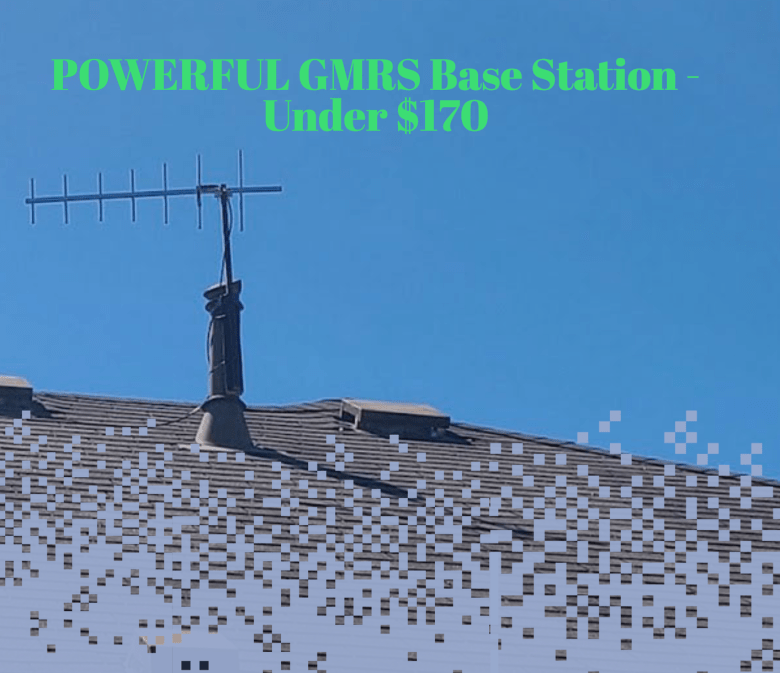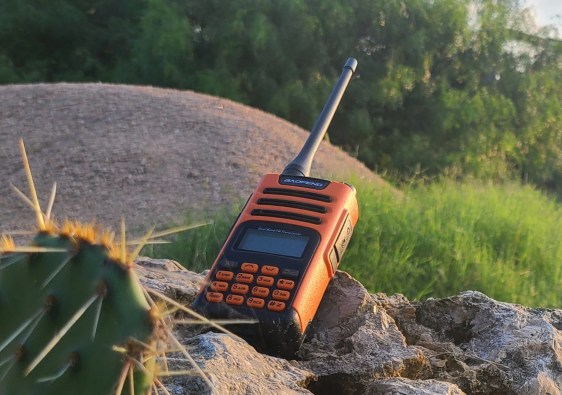Here’s how we made a powerful GMRS base station using a Yagi beam antenna that gives us over 35 watts of effective radiated power output (ERP) from our cheap Baofeng handheld. Our simple GMRS base station cost us about $166 to make and can communicate with our family’s other handheld radios all across an urban area 5-7 miles away from our home, as well as with with our two mobile radios up to a distance of twenty miles away, using a cheap radio with only 4.6 watts of power.
Please note that a $35 GMRS license is required (covers a family for 10 years) to use a base station setup like the one described. See How to Get a GMRS License for more info.
This setup is not for use on GMRS channels 1-7, where the FCC limits ERP to 5 watts or channels 8-14, where power is limited to 1/2 watt. On GMRS channels 15-22 the FCC allows 50 watts of RF output power, with no apparent limit on effective radiated power.*
Why We Chose This Setup For Our GMRS Base Station
After moving to our new home, we were looking for an emergency backup communications system that our family could use to stay in touch if cell service was disrupted. Before moving to the Austin, TX area we lived down on the Gulf Coast and having experienced a couple hurricanes, know just how easily this can happen, as well as how long it can be before normal communications are restored following a disaster.
All we wanted was a system that was always on, in standby mode, to use if we really needed it, but we didn’t want to spend a fortune.

Why a Beam Antenna For Our GMRS Base Station?
At first we considered using a high-gain omnidirectional GMRS antenna, capable of receiving signals in all directions, however the areas where we’d most likely need reach (our spouse’s workplace and shopping areas) are more or less in the same general direction from our home, so we decided a GMRS beam antenna might work best.
Directional antennas, like the 11 dB gain Yagi antenna we used, radiate most of their power forward in a narrow path, with some coverage toward the back and sides, as seen above. We still have coverage with our mobile units up to 5 miles behind and to the sides of where the antenna is pointing, but the best reception is within about 60 degrees of where the Yagi is pointed.

Setting Up our GMRS Beam Antenna On The Roof
We live in a community that has an HOA, so having a GMRS base antenna that wasn’t visible from the street was a requirement. The HYS UHF Yagi antenna that we used measures only 38″ long by 14″ high and doesn’t look so obvious as some vertical antennas do. We mounted the antenna on a 2.5′ aluminum pole, which we painted to match a vent pipe on the roof, then attached it using two large hose clamps, which we also painted black.
The height of the Yagi antenna as mounted on our roof ended up being 25′ above ground. From this elevation we have clear line of sight to most of the area we needed to reach.
A CA-35RS lightning suppressor was installed where the PL-259 connector attaches to the base of the Yagi antenna. We then ran a bare copper ground wire down the side of the roof valley, stapled at 3′ intervals, and connected it to a ground rod driven 6′ into the earth.
Next, we ran the coaxial cable into the attic through one of the roof vents and then down through a hole drilled into the ceiling of a coat closet in the living room. (Even after running the coax from the closet to our desk we still had some left over. Be sure to measure so you don’t buy any more than you need.)
Check The SWR – After hooking up the Yagi antenna to our Baofeng UV-9G, using a SMA female to SO-239 connector, we then checked the SWR, (Standing Wave Ratio) using our meter to make sure that the antenna was tuned correctly.
The HYS 7 element UHF Yagi we used is resonant between 400 and 470 Mhz, with the high power GMRS channels 15-22 being in the 462 Mhz range. We measured SWR of 1.2, which is considered very good for any antenna.

Boosting Our 4.6 Watt Baofeng UV-9G to 35 Watts!
Using our Surecom SW-102 Watt/SWR meter, we measured our Baofeng UV-9G’s RF output at 4.6 watts. Using the calculator above indicated we should get an effective radiated power or ERP from our budget GMRS base station (not accounting for some line loss) of just over 35 watts.
Always on Standby – We keep the handheld on all the time, set to one of the high-power GMRS channels and using CTCSS tone squelch most of the time to reduce unwanted traffic from FRS radios*. A handheld mic comes in handy and so far there have been no issues when using the radio while it’s charging.
*When using CTCSS or DCS “privacy codes” others always remember to check if someone is using the channel before transmitting. When traveling off-road we never use these codes to mute our squelch, but find them a necessary evil in urban areas because of high numbers of FRS walkie talkies using the same channels.

Items We Used For Our Budget GMRS Base Station
The following items can be purchased on Amazon*
- Baofeng UV-9G GMRS Handheld – Cost – $34
- 50′ of RG8x Coaxial Cable with UHF PL259 Male to Male Connectors – $38
- SMA Female to SO239 Female Connector – $7
- HYS 7 Element Yagi (11 dB gain) – $70
- External Mic for Baofeng UV-9G – $6
- CA-35RS Lightning Arrestor – $11
Total Cost For GMRS Base Station and Yagi Beam Antenna: $166
GMRS Base Station Install Tips:
- Thoroughly tape the coax to antenna connection with UV resistant electrical tape such as 3M Super 88 to prevent corrosion.
- Install a lightning arrestor, such as the Workman A28 or CA-35RS. (Always be sure to unplug your radio before a thunderstorm.)
- Use Google Earth and a handheld compass or phone app to align your Yagi antenna in the best direction.
- Check your SWR or radio to antenna match using a meter such as the Surecom SW-102. See our article How to Set GMRS Radio SWR for more info.
What Would We Do Different Next Time?
So far this system works great as-is. We’ve thought of upgrading the handheld to a fixed-mount mobile attached to a 12 volt power supply, but this setup has performed so well that we’ll just leave it as is for now. Adding a more powerful transceiver would be unnecessary and with our 11 dB gain Yagi being so powerful, added power could interfere with other users over a larger area than we need to cover. Just 4.6 watts works to cover most a large urban area that’s located to the east of our suburban home.
Also, we could have used a shorter coaxial cable instead of one that was 50′, for less signal loss. There are more expensive coax cables with very low loss, made by Times Microwave, but this would have added about $70 to our system’s cost.

How is It Working?
There are some areas of town where our handhelds won’t work, but generally if we can get near a west facing window or outside of the building we can establish contact with the base station. (We do use 15″ Nagoya NA-771G GMRS antennas on our handhelds most of the time and while these can be a bit cumbersome they do boost the signal quite a lot.)
Our farthest contact with this setup has been from our home near Austin, TX to a mobile station using a repeater located in Conroe, TX (136 mi). This long distance GMRS contact was mostly possible due to a “band opening” or favorable atmospheric conditions.

Will This Setup Work For You?
GMRS radio waves are UHF and travel mostly along the line of sight. If large obstacles, such as towering buildings, hills or even heavy tree cover lie between you and the station you want to talk to, no amount of power or high-gain antennas will make a setup work. If you’re in a situation where you want to talk to mobiles or handhelds, located mostly in one general direction from your home, and don’t have a lot of obstacles in the signal path, chances are a GMRS base station using a Yagi beam antenna like this might work for you.
*The information in this post regarding FCC rules is correct to the best of our knowledge. Be sure to verify and follow all FCC rules regarding antenna height and effective radiated power for GMRS channels and don’t operate without a GMRS license.
*This post may include affiliate links to products we recommend.





